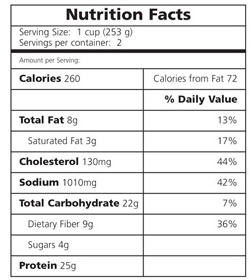Reading a food label
Labels can give you useful information on which to base your food choices. Ingredients are always listed in decreasing order of weight. Sugar is also called fructose, glucose syrup, maltose, or dextrose. Looking at the position of these names on the list will help you gauge the quantities of sugar.
Energy Written as kilocalories (kcals), usually shortened to calories, and kilojoules (kj) – this information can help if you are calorie cutting to lose weight. Generally, opt for low-calorie products.
Protein Protein is unlikely to cause large fluctuations in your blood glucose level, or affect your weight.
Carbohydrates The total amount of carbohydrate is given, and how much of that is made up of sugars. A healthy amount of sugar per 100g is 2g or less – the higher the sugar content, themore likely you are to gain weight.
Fat Choosing items with a lower fat content (3g or less per 100g) will help you lose weight. Foods with a higher proportion of poly- or monounsaturated than saturated fats are healthier.
Fiber Choosing foods with a higher fiber content will help you toward the recommended 25g a day.
Sodium This is the salt content and limiting your intake (to 100mg or less per 100g) will be beneficial to your blood pressure.


